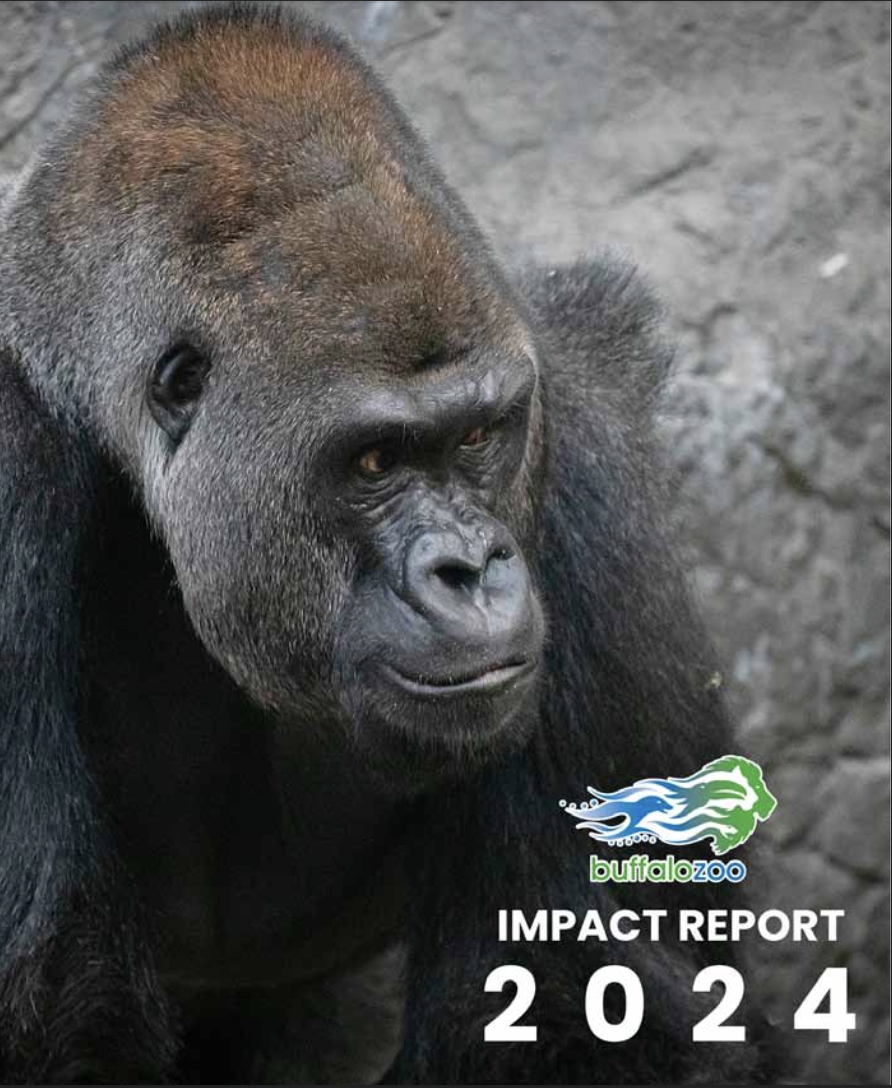About
Online ticket purchases are coming to the Buffalo Zoo in early 2018!
Until this feature is live, please call 716-837-3900 for additional ticket information and visit the zoo to purchase tickets at the box office.
Celebrating 150 Years
Learn more about the 3rd oldest US zoo!
An Overview of the Buffalo Zoo
The Buffalo Zoological Gardens is the third oldest institution of its kind in the United States. The Zoo’s mission is to provide the general public with an educationally, culturally and recreationally significant community resource. This is accomplished through the advancement and encouragement of the science of zoology, through the conservation of the world’s wildlife and through the innovative exhibition of diverse species of mammals, birds, reptiles, amphibians and fish.
Originally conceived as a deer park in the northeast corner of Frederick Law Olmsted’s Delaware Park, The Buffalo Zoo was established in 1875. Spurred on by local donations of animals, The Zoo grew and rapidly developed between 1875 and 1930 and attracted great community interest and involvement. This growth led to the Zoological Society of Buffalo being founded in 1931. The Society worked with the City of Buffalo to effect many improvements to The Zoo over the next four decades. Included in this period was a major renovation (1938-1942) by the Works Progress Administration (WPA), which featured buildings using classic, period architecture.
In 1973, operational responsibilities for the Zoo were turned over from the City of Buffalo to the Society, which assembled a professional staff to provide care and oversight for the collection. Since the Society assumed leadership for the Zoo, important capital projects have been completed. Improvements are continually made to make the Buffalo Zoo responsive to the animal’s needs and a great venue for family outings, recreation and education.
Today, the philosophy of the Buffalo Zoo is to exhibit animals and plants in ecological habitats and geographical arrangements that represent the biomes of the world. Current programs focus on providing visitors with a better understanding of the natural world, how animals relate to each other, to their environment and to humankind. No longer are animals housed at the Buffalo Zoo solely for the amusement and entertainment of visitors, but rather, are presented to increase awareness for the importance of conservation for the benefit of both the animal kingdom and the human race.
1875
February 23, 1875

The Zoo traces its history to 1870, when Jacob E. Bergtold, a prominent furrier, presented a pair of deer to the City of Buffalo. The deer were housed on a small piece of land in Delaware Park. Five years and a few animals later, the first permanent building was erected, signifying the establishment of the Buffalo Zoological Gardens in 1875. Over the next fifteen years, a flock of sheep, a pair of bison and eight elk were added.
1890
February 23, 1890

In 1890, development continued with the construction of a bear exhibit and a larger animal house. With these additions, public awareness began to grow and, as a result, many animals were donated to the Zoo. Due to the rapidly growing animal collection, the City hired Frank J. Thompson as the Zoo’s first curator in 1895.
1912
February 23, 1912
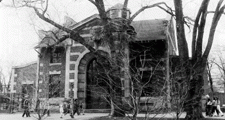
In 1912, the elephant house was completed for the Zoo’s new elephant. Other animals on display during this period included: badgers, bears (black, brown, and polar), fox, moose, raccoon, sea lions, wolves, and woodchuck. An estimated 20,000 to 30,000 people visited the thriving animal collection on a beautiful day in the early 1900’s.
1929 – 1942
February 23, 1929

In 1929, there had been no City funded improvements at the Zoo for 17 years. Area citizens began suggesting the formation of a Zoological Society to raise both funds and public interest for the Zoo, as had proven successful in other cities. In November 1930, Mayor Roesch held a public hearing to discuss the matter of Zoo improvements, a meeting brought on by newspaper editorials and a group of concerned citizens. The band, under the leadership of Stuart T. Goldberg, incorporated the Zoological Society in 1931.
1938
February 23, 1938

The redevelopment of the Buffalo Zoo began under the direction of the Works Progress Administration. The modernization project, estimated to cost $1.5 million, included construction of the Main Animal Building. Marlin Perkins, who was hired as curator in 1938 from the St. Louis Zoo, further revived the Zoo. Under Curator Perkins, the animal collection flourished into what was considered one of the finest in the country. In 1942, the Reptile House was opened with more than 400 specimens and declared by Perkins to be “the finest reptile house in America.“
1958 – 1967
February 23, 1958

Over the next 20 years, financial difficulties limited the Zoo’s growth, but the City attempted to move forward. Revenues were generated through the addition of a train ride and concession stands in the early 1950s. In October of 1958, the Zoo was closed for five months to undergo $300,000 worth of repairs including a new sewer system, renovation of the elephant house, and reconstruction of the small mammal house. In 1965, ground was broken for the Children’s Zoo, a project funded by the Rotary Club of Buffalo. With the improvements very well received, the Buffalo Zoo’s attendance increased to over 1 million visitors in 1965-66. In 1967, the Giraffe House and Animal Hospital were opened.
1972
February 23, 1972
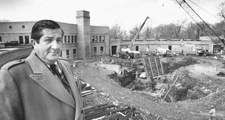
Operation of the Zoo was turned over to the Zoological Society in January of 1973. The City and for the first time, Erie County, provided the Zoo with a $350,000 budget. An admission fee was introduced to generate revenue for much-needed renovations, and the Naval Reserve provided assistance for Zoo improvements. During the 1980s and 1990s, the number of animals in collection began to be reduced, with emphasis placed on breeding and reproduction of rare and endangered species. Following along with national zoo trends, many new exhibits opened during this time period.
1980 – 1999
February 23, 1981

In 1981, the Gorilla Habitat was constructed. In January 1984, the Children’s Resource Center opened, housing the Education Department and the Dr. Charles Drew Science Magnet School. The Lion and Tiger Habicat was completed in the summer of 1988. The Parkside Entrance and Zootique were completed in the summer of 1992. In 1996, the hyena exhibit was constructed. Other improvements included the Boehm Porcelain Gallery (1984), the Diversity of Life Hallway (1992), the Elephant Yard Renovation (1993), the World of Wildlife Interpretive Center (1993), and the Children’s Zoo renovation (1997).
2002
January 1, 2002

In 2002, The Buffalo Zoo developed a new master plan to guide future development of the Zoo. Since then, several new exhibits have opened including: Vanishing Animals (2002), The Bone Zone (2002) Ecostation (2003) and Otter Creek (2004). Under the direction of the Zoological Society Board, the Buffalo Zoo has completed Phase One of its 15-year master plan. In 2002, the Buffalo Zoo developed an exciting master plan to completely transform the Zoo with major new exhibits and visitor facilities. The core experience of the new zoo will be a series of realistic, immersive animal enclosures that take visitors on a journey around the world. Primary exhibit zones, accessed off a central pathway, include African Watering Hole, South American Rainforest and Arctic Edge.
2008
February 23, 2008
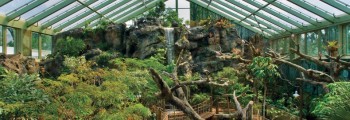
M&T Bank Rainforest Falls and the Delta Sonic Heritage Farm. Opened in 2008, Rainforest Falls is a fully enclosed South American exhibit providing the new Zoo with a signature four-season attraction. Visitors will walk through trees via a series of ramps and overlooks. Along the way, they will encounter a remarkable collection of species that live at different levels with the rainforest including squirrel monkeys and white-faced sakis, piranhas, roseate spoonbill, scarlet ibis, toucans, boat-billed herons, tamandua, and vampire bats. The forest floor features larger species such as capybara, ocelot, giant anteaters, armadillos, giant river turtles, dwarf caiman and anaconda.
2013
July 11, 2013

he Delta Sonic Heritage Farm opened in 2010 and became the Zoo’s new year-round children’s Zoo. The farm features a genuine heritage barn from the 1800 to recreate the feeling of what life was like on the Erie Canal in the 1800s. Complete with its own garden, the heritage farm is home to Berkshire pigs, a Devon cow, Southdown sheep, Dominique chickens, turkey and a mule similar to those used to tow boats along the Erie Canal. A new entrance to the Buffalo Zoo was constructed in 2013 next to the parking lot. Read More on WBFO News
2015
September 12, 2015

The Arctic Edge will be a walk-through habitat focusing on frozen water. The major attraction will be an enclosure housing several polar bears. Underwater viewing will enable visitors to get an up-close look at the bears’ swimming styles and playful antics. Other enclosures feature Arctic wolves, Lynx, and the majestic Bald Eagle. Arctic Edge will be a dramatic new habitat focusing on the snowy, frozen climate of the Arctic Circle. The Polar Bear complex will be comprised of four distinct zones – the Exhibit Area, the Holding Dens, a Cubbing Den, and Management/Service areas for diet preparation, mechanical operation, and life support systems.
Our Mission
The Buffalo Zoo: building community→ creating connections→ saving wildlife
Our Vision
Collaborating for Change: The Buffalo Zoo will be a center of conservation excellence, providing leadership to secure a future where wildlife thrives.
We embody our mission and vision through practices that exemplify the following values:
WE ARE ONE TEAM: We recognize that no one person, area, or department would be successful alone. We all work together to fulfill our mission and understand that the unified sum of the whole is greater than the individual contributions we make. We pledge to:
o Foster a sense of teamwork through being supportive of each other’s efforts.
o Trust each other’s professional expertise while valuing the observations of othersWE WELCOME ALL: We pledge to be inclusive through:
o Respecting a diversity of opinions, backgrounds, values, and perspectives.
o Being friendly and welcoming to our guests and each other.
o Listening to and being open to other ideas.WE HAVE INTEGRITY: Honesty and transparency with each other, our guests and our community is paramount to achieving success. We will:
o Actively engage in two-way communication and knowledge sharing of information critical to completing our mission successfully.
o Share information freely and proactively recognizing that in some situations not everyone will have all the information.
o Be truthful, accept responsibility for our actions and hold each other accountable.WE CARE: We care for our animals, our campus, our guests and each other by:
o Being kind and empathetic in our interactions.
o Providing the best welfare and husbandry to our animals.
o Supporting each other when things are going well and when things are not going well.
o Committing to a work environment characterized by open communication,
collegial respect, and collaborative spirit.WE GO ABOVE AND BEYOND: We strive to be exceptional and excellent in all we do through:
o Utilizing facts, data and science to drive decisions.
o Innovation, creativity, resourcefulness, and resiliency.
o Valuing what has worked and living a culture of continuous improvement.
o Being good financial stewards.
o Modeling environmentally sustainable behaviors.If you would like to learn more about the Buffalo Zoo and what stand for, get in touch with us today. We are proud to offer educational and rewarding animal experiences to the Buffalo, NY area! Whether you are looking to bring your students for an educational field trip you want to bring the zoo to you with our mobile zoo service, we are here to inform and give you an unforgettable animal experience in Buffalo, NY.
Our Team
Buffalo Zoo Leadership
Zoological Society of Buffalo, Inc.
Lisa Smith – President & CEO
Denise Schaefer – Chief Financial Officer
Christine Fontaneda – Chief Advancement Officer
Board of Directors – 2024/2025
Chair
Eugene P. Gramza, Jr.
Chair Elect
Michelle A. Sullivan
Vice Chair
Lisa Ceglia
Vice Chair
Rylan O. Rawlins
Vice Chair
John R. Yurtchuk
Treasurer
Rajiv Ranjan
Secretary
Nicole R. Tzetzo
Immediate Past Chair
David P. Flynn
Board Member
Barbara T. Baker
Sergio P. Gangarossa
John T. Gavigan
Craig A. Harris
Sean Heidinger
Christopher P. Kania
Brian J. Kulpa
Paul Millstein
Ronald Mornelli
Susan O’Sullivan
Elizabeth Potozniak
Donna M. Siwek
Michael T. Ulbrich
Kanishka Wanninayaka
Abigail L. Zabrodsky
Director Emeritus
Dorothy T. Ferguson
Donna M. Gioia
Robert M. Greene, Esq.
Ex-Officio Member (Voting)
Cavette A. Chambers
Joel P. Feroleto
Susan Gingrich
Denise Lanz
John R. Sanderson
Christopher P. Scanlon
Brandon Schulz-Koller
Ex-Officio Member (Non-Voting)
William Conrad
Michael H. Kooshoian
Mark C. Poloncarz, Esq.
Sean Ryan
Jeremy Toth
| Member | Position | |
Buffalo Zoo Vision
Introduction
Wild Impact: A Vision for the Buffalo Zoo
Buffalo is evolving, and so is its Zoo. With a vision for cutting edge habitats, immersive experiences and a commitment to wildlife conservation.
We’re celebrating our 150th year by setting the state for the next 150 years. This is an opportunity to take part in preserving a legacy, while forging a new future for our Buffalo Zoo.
What's Next for the Zoo

New Gorilla Habitat
■ Create a new Gorilla outdoor exhibit on empty grass area quadrupling the size of existing indoor exhibit
■ Fulfills AZA requirements, possible troupe expansion
■ Overhead transfer bridge from existing Gorilla House
■ Renovations to existing Gorilla House interior exhibit
■ Landscaped for interest: large jungle gym, ropes/vines, obstacles, elevated plateau & depressed areas,
concrete jungle trees, heated rocks, plantings, etc.

Expanded Big Cat Habitat
■ Double the size of existing Tiger & Lion enclosures.
■ Provide covered visitor viewing & seating;
■ Shaded pedestrian viewing corridor / building egress along Gorilla House wall
■ Two separate exhibit areas to accommodate alternate tiger groupings, breeding, etc.;
■ Refreshed landscaping for interest: elevated stone plateau, heated rocks, plantings, etc.
■ Renovated/enhanced water feature, incl. waterfall, stream, and bathing pool;
■ Restore Big Cat enclosure historic window wrap-around WPA-era bas reliefs

Indoor Dinning Areas
■ Build two elegant, modern climate-controlled indoor dining areas; opposite proposed Gorilla Yard
■ Enclosed corridor: connecting the two eateries.
■ Renovation of kitchen designed to also provide space for catering events in adjacent Event Tents & CLC;
■ Interior Access to Existing Restrooms
■ Thermopane glass walls for yearlong comfort; large windows facing North for natural light;

Carousel Enclosure: All-Season Attraction
■ Move historic ‘Crystal Beach’ Carousel to central raised area & enclose in all-weather structure
■ New steel and glass all-weather carousel building for continuous annual operations
■ 10-sided Decagonal structure w/ tiered roof for natural light & ventilation
■ Garage doors on four (4) sides for open-air warm weather operations
■ Thermopane glass walls on six (6) sides to view carousel
■ Electric heaters in ceiling for cold weather periods
■ Seating around the carousel perimeter of interior & exterior for visitor comfort

Virtual Reality Immersion Theater Dome
■ Install VR Dome Immersion Theater within former ‘Arctic Edge’ pavilion.
■ Accommodates up to 20 sitting or 30 standing vistors per show
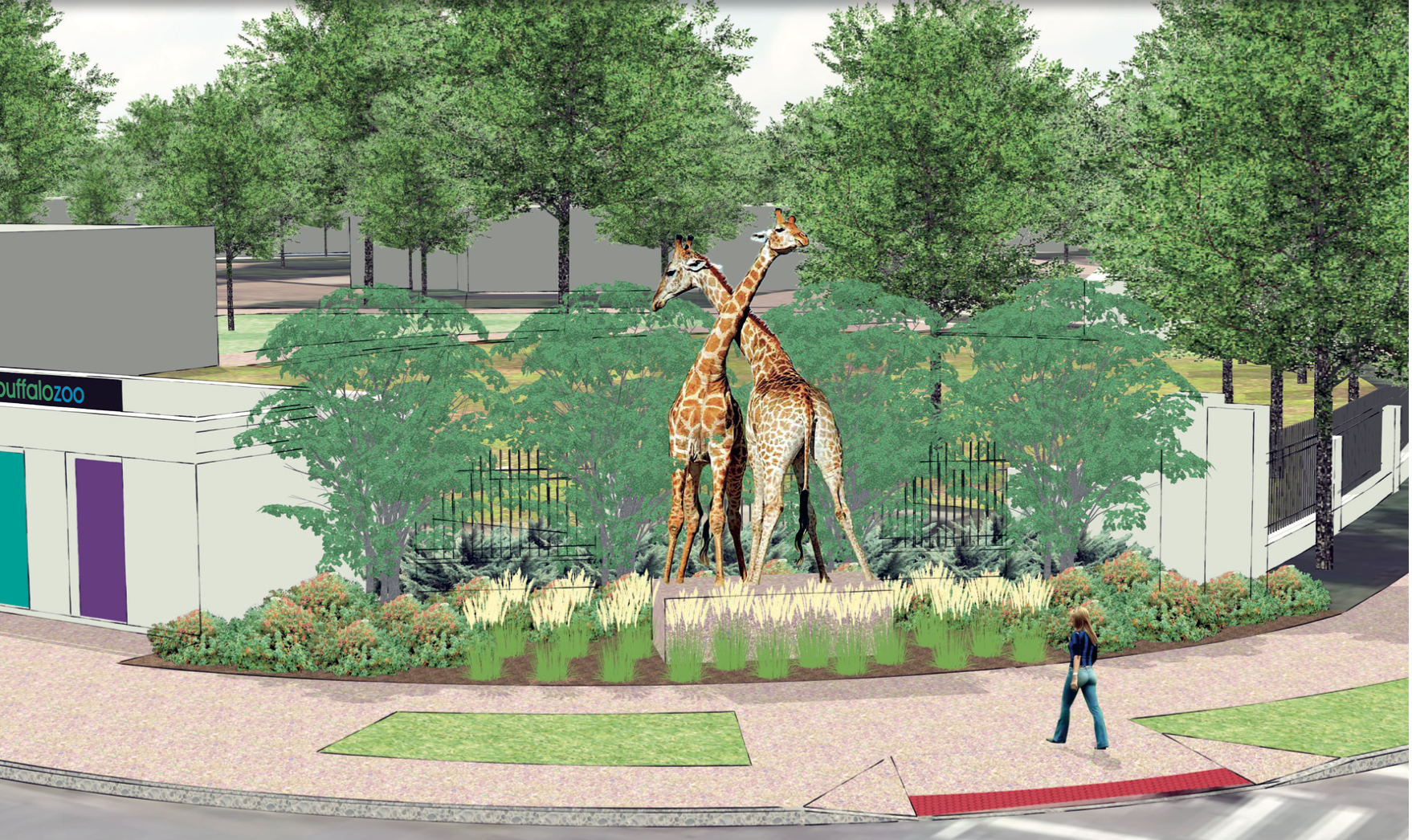
Exterior Monument
■ Compelling, life-size animal monument on Zoo perimeter to command attention & publicity;
■ Highly visible from all directions;
■ Provides important placemaking, marketing & directional cues for donors, visitors & passersby;
■ Area to include Buffalo Zoo sign(s) atop historic trolley station structure;
BECOME A BUFFALO ZOO VOLUNTEER!
We can’t thank our volunteers enough! – As a 501(c)(3) non-profit, we rely on volunteers in almost every aspect of the Buffalo Zoo; from education, to animal care, to fundraising! Over 200 volunteers have created a community dedicated to supporting wildlife conservation and enhancing the guest experience.
If you are interested in any of these volunteer opportunities, please contact the Volunteer Manager at volunteer@buffalozoo.org or (716) 837-3900 ext. 150 or (716)-599-1051
Docents
- Reach out and teach someone! Become a member of the Zoo’s very active corps of volunteer educators known as Docents. Established in 1974, the Docent Organization’s goals are to help the Buffalo Zoo Education Department “educate, unite, and involve people in the conservation and preservation of the natural world.” With over 100 active members, the Zoo’s dedicated volunteer organization plays an essential role in Buffalo Zoo programming both on and off zoo grounds.
- Docents interact with zoo visitors, assist with scheduled Education programs, and interpret various props throughout the Zoo. With additional training, Docents may participate in camp, animal handling, and onsite and offsite programming.
- Requirements: Applicants must be 18 years of age or older. Docents must complete a mandatory orientation and multi-week (in-person and online) training course. All applicants will be interviewed and undergo a background check.
- Commitment: We ask that docents commit to at least one year. Generally, docents work 2-3 shifts per month. Shift days and times vary.
If you would like to inquire about Docent Orientation and Training program, please contact the Volunteer Manager at volunteer@buffalozoo.org or (716) 599-1051.
We are always accepting Docent applications. Orientations usually occur in fall/winter and trainings usually occur in the spring.
If interested, please fill out the online application below.
Please direct any questions to the Volunteer Manager at volunteer@buffalozoo.org or (716) 599-1051.
Adult Volunteers
- Adult Volunteers help with episodic volunteer needs including promotions, special events, membership. Duties might include assisting with crafts, games, or event registration.
- Adult Volunteers periodically receive emails, which list dates, times, and activities for which we need volunteer participation. This program is perfect for those who need a flexible volunteer schedule, but still want to become involved at the Zoo.
- Requirements: Applicants must be at least 18 years of age.
If interested, please contact the Volunteer Manager at volunteer@buffalozoo.org or (716) 599-1051.
Teen Volunteers
- Teen volunteers help with special events throughout the year. Duties might include assisting with crafts, games, or taking tickets.
- Fulfills student community service requirements
- Requirements: Applicants must be between the ages of 14-17
- Students/Individuals under the age of 18 looking for more in depth opportunities, click here.
If interested, please contact the Volunteer Manager at volunteer@buffalozoo.org or (716) 599-1051.
Buffalo Zoo Pro Zoo Board - Volunteer Opportunity
- If you are interested in helping our animals and enjoy the challenges and excitement of fundraising, consider joining the ProZoo Board of the Buffalo Zoo. ProZoo Board activities include hosting at least two events a year, one being Wines in the Wild. We also volunteer at many events the Zoo hosts throughout the year.
- We hold monthly meetings on the second Thursday of each month at 5:30 PM. If you are interested or would like more information please email the prozooboard@gmail.com.
Buffalo Zoo Women’s Board - Volunteer Opportunity
- If you are interested in helping our animals and enjoy the challenges and excitement of fundraising, consider joining the Women’s Board of the Buffalo Zoo. Women’s Board activities include our annual photo contest, basket auction for Wines in the Wild, annual holiday luncheon and more!
- Monthly meetings occur on the first Monday of each month (except holidays) at Noon at the Zoo. Click Here to view our Women’s Board Facebook page and to obtain an application.
Animal Department Internships
Interns placed in the Zoo’s Animal Department work side by side with animal keepers during their daily routine. This intensive on-the-job learning exposes the intern to the full range of exotic animal husbandry including, but not limited to:
- Cleaning
- Diet preparation and feeding
- Training and Enrichment
- Observing and noting normal and abnormal behaviors
- Procuring supplies
- Maintaining exhibits
- Interacting with the public
Applicants apply to the general internship program. Area placement is dependent upon experience and availability. All internships are unpaid.
REQUIREMENTS: Internships are designed for students currently enrolled in an undergraduate or graduate program in zoology, biology, or a related field. Interns must be available at least one full day per week, but the exact schedule will be determined by the keeper and the student based off needs and availability.
Interns must feel comfortable working in a variety of weather conditions and be capable of lifting at least 50lbs. You must present yourself in a professional manner.
Students requesting college credits for the internship must have their schools provide proof of liability insurance coverage.
If accepted into the internship program, interns must provide proof of a negative reaction to a tuberculosis (TB) test performed within six months prior to the start of the internship. Interns must also provide proof of current COVID vaccine.
HOW TO APPLY: Please submit the ONLINE APPLICATION BY CLICKING HERE and send a cover letter and resume to volunteer@buffalozoo.org.
Please note, you will be informed of your acceptance or rejection via email and given next steps. We do take applications for each semester, however the number of students accepted into the program is limited.
Veterinary Department Internships
Interns in the veterinary hospital function in a preceptorship capacity under the guidance of the Zoo’s veterinarian and technical staff. Interns with the Zoo’s Veterinary Hospital receive the opportunity to observe and potentially assist in a variety of regular as well as specialized veterinary procedures and techniques that may include:
- Processing radiographs
- Maintaining medical records and filing
- Surgery preparation and cleanup
- Observing surgery, necropsy, and animal treatments
- Parasitology, hematology, and cytology preparation and evaluation
- Surgical patient monitoring
The full extent of internship duties is based wholly or in part on previous experience. All internships are unpaid.
REQUIREMENTS: Internships are designed for those with a background in veterinary medicine or for students currently enrolled in veterinary science program or a related field. Interns must be available at least one full day per week, but the exact schedule will be determined by our veterinary staff and student based on needs and availability.
Interns must feel comfortable working in a variety of weather conditions and be capable of lifting at least 50lbs. You must present yourself in a professional manner.
Students requesting college credits for the internship must have their schools provide proof of liability insurance coverage.
If accepted into the internship program, interns must provide proof of a negative reaction to a tuberculosis (TB) test performed within six months prior to the start of the internship. Interns must also provide proof of current COVID vaccine.
HOW TO APPLY: Please submit the ONLINE APPLICATION BY CLICKING HERE and send a cover letter and resume to volunteer@buffalozoo.org by the following deadlines.
Please note, you will be informed of your acceptance or rejection via email and given next steps. We do take applications for each semester, however the number of students accepted into the program is limited.
Work at the Buffalo Zoo!
Come work for one of the largest culturals in Buffalo! Scroll down to see what positions are currently available at the Buffalo Zoo and how to apply.
HOW TO APPLY FOR EMPLOYMENT
When possible, the Zoo will fill job vacancies with qualified internal candidates. As necessary, vacant positions will be advertised on the Buffalo Zoo website and on selected professional publications/online job posting websites.
Individuals interested in employment with the Zoo may obtain an application by downloading the form off of our website; by contacting the Zoo at (716) 837-3900 Ext. 100; or applications may be obtained at the General Admissions Gate.
Completed applications/resumes may be submitted one of three ways:
By email:
By regular mail:
Buffalo Zoo(Att: Human Resources Dept.)300 Parkside AvenueBuffalo, NY 14214
In-person:
Applications can be returned to the General Admissions Gate. No phone calls please!
All applications and resumes will be held on file for one year. These applications/resumes will be reviewed if an appropriate position becomes available.
The Buffalo Zoo invites you to apply for the following positions:
Zoological Manager
Guest Experience Associate
Guest Experience Clean Team Associate
Maintenance Technician
Stationary Engineer - Full Time
AN EQUAL OPPORTUNITY EMPLOYER
The Buffalo Zoo is an equal opportunity employer and does not discriminate in its employment decisions on the basis of race, color, religion, national origin, age, sex, disability, veteran status, genetic predisposition, carrier status, sexual orientation, and all other categories covered under federal and local law.
The Buffalo Zoo is dedicated to conservational education and currently plays an essential role in a variety of local, regional and global conservation efforts. Education is a vital part of the institution’s mission, enabling the Zoo to teach people how they can help save our world’s wildlife.

The Buffalo Zoo, AZA, and You: A Natural Connection
Zoos and aquariums are always fun and educational to visit. You can also feel great about your visit to the Buffalo Zoo for other reasons, too. As an institution accredited by the Association of Zoos and Aquariums (AZA), we’ve met rigorous, professional standards for animal management, veterinary care, wildlife conservation and research, education, safety, staffing, and more.
Fewer than 10% of the USDA-licensed wildlife exhibitors in the United States are accredited by the Association of Zoos and Aquariums. We are proud that the Buffalo Zoo has met the high standards set by AZA. When you purchase a ticket or make a donation, it helps fund our programs (including our conservation activities) and exhibits. We want to thank you for your part in the Buffalo Zoo’s continued success as well as the success of the Association of Zoos and Aquariums.
We know people are increasingly interested in animal welfare and in connecting young people with nature. These issues are at the heart of the Association of Zoos and Aquariums. AZA is an international organization that sets high standards for zoos and aquariums.
Looking for the AZA accreditation seal is the simplest way to be sure you’re not just being entertained, but you’re patronizing a facility where high quality animal care is paramount and conservation education programs are based on solid science.
With more than 200 accredited members, AZA is a leader in global wildlife conservation. Each year, AZA member institutions participate in about two thousand conservation projects in about 100 countries and invest tens of millions of dollars in programs to help wildlife.
In addition, every year, staff at these institutions contribute to our understanding of wildlife biology and conservation by publishing hundreds of books, book chapters, journal articles, conference proceedings papers, posters, theses or dissertations.
AZA also works cooperatively with the U.S. Congress, federal and state government agencies, and international conservation organizations on legislative and regulatory matters pertaining to animal welfare, wildlife conservation field programs, conservation research/education initiatives, and the public display of wildlife, including animal care and husbandry, transport and breeding.
AZA participates in a number of international treaties and conventions impacting wildlife, including the Convention on International Trade in Endangered Species (CITES), the International Whaling Commission, and the Convention on Biological Diversity.
For more information on any of these efforts, visit www.aza.org.

Species Survival Plan (SSP)
The AZA’s Species Survival Plan (SSP)©, is designed to help ensure the survival of selected wildlife species. The program began in 1981 as a cooperative animal management effort for select species. Each SSP manages the breeding of a species in order to maintain a genetically diverse and demographically stable population.
For more information on the SSP program, visit www.aza.org.
Buffalo Zoo Horticulture
Since 1875, our team of dedicated horticulturists has been beautifying the 23½-Acre landscape at the Buffalo Zoo. With a diverse collection of over 300 plant species, there is plenty for visitors to enjoy every season of the year – rain, snow, or shine. We hope you visit often so you can see and experience your favorite plants and animals!

Native Plants
A number of plants indigenous to the Buffalo Niagara region can be found right here throughout the Buffalo Zoo. The native plants in our collection are self-sustaining, naturalized plants that encourage beneficial insect populations such as butterflies and pollinating bees. A few noteworthy native plants include red osier dogwoods at Otter Creek, seasonal perennials at Delta Sonic Heritage Farm such as butterfly weed, and a massive 200 plus year old Bur Oak tree in front of the M&T Rainforest Falls building.
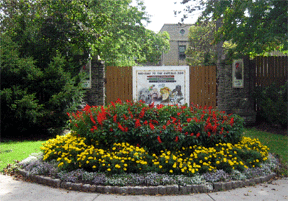
Seasonal Color
The seasonal color beds, planter boxes, and hanging baskets at the Buffalo Zoo draw attention to entranceways and enhance views throughout the landscape. Visitors have the opportunity to enjoy a unique combination of colorful annuals and perennials that last all summer long. We hope the seasonal color at the Buffalo Zoo puts some extra spring in your step during your visit.

Tropical Plants
There are over 100 unique and interesting tropical plant species at the Buffalo Zoo. Used to simulate animals’ native habitats, these eye-catching tropical plants make up the interior landscape at the M&T Rainforest Falls, gorilla, and reptile exhibits. A state-of-the-art greenhouse directly adjacent to the M&T Rainforest Falls building houses an inventory of tropical and seasonal color plants that are cared for until they are incorporated into the interior and exterior landscapes at the Buffalo Zoo.

Landscape Conservation
The Buffalo Zoo and its team of horticulturists are committed to environmental stewardship. Several conservation efforts are in-place in addition to the use of native plants. Ornamental grasses are fed to various hoof stock and primate animals once they are cut back at the end of each growing season. Carefully selected deciduous and evergreen branches from pruning woody ornamentals are utilized for enrichment in animal exhibits. Biological controls are utilized as-needed to naturally manage pest pressures for interior landscapes.
Affiliations
We are proud members of the Association of Zoological Horticulture and the Western New York State Nursery & Landscape Association. We regularly engage in continuing education to help us improve the grounds and animal exhibits at the Buffalo Zoo. We do this with the intention of being the very best zoo that we can be while fulfilling our education, recreation, and conservation mission at the horticultural level.
Connect with Conservation!
A great way to find out about local and global conservation efforts and ways to help!
eelink
Check this out! This site is an extensive resource for links to information about endangered species and environmental education!
Visit WebsiteEarth's Endangered
This site has good summaries of topics related to endangered species. Click on the following for information:
· Endangered species in your state (map)
· Interesting Facts
· Causes of endangerment
ES2000 Endangered Species of the Next Millenium
This site is full of great information and is well-organized. Check out interesting facts and ways to help.
Visit WebsiteEPA
There’s information on recycling, pollution, the environment, games for kids and much more.
Visit WebsiteInternational Union for Conservation of Nature and Natural Resources
This site is the official web site of the International Union for Conservation of Nature and Natural Resources. It includes information about the status of animals on the Red List.
Visit WebsiteJane Goodall Institute
Learn more about Roots & Shoots and Jane Goodall’s work with chimpanzees.
Visit WebsiteNational Wildlife Federation
Click on environmental education for great educational information and ways to help save wildlife.
Visit WebsiteNature Conservancy
Find out how the Nature Conservancy is trying to achieve lasting conservation results.
Visit WebsiteNatureServe
If you’re doing educational, scientific, and/or land management research on biodiversity and conservation, then this is the site for you
Visit WebsiteNew York State Department of Environmental Conservation
Find out about conservation in New York State.
Visit WebsitePuerto Rican Crested Toad Conservation
AZA information on Conservation, Education and Reintroduction of the Puerto Rican Crested Toad
Visit WebsiteU.S. Fish and Wildlife Service
Click on the link above for the following information:
· How Can Kids Help?
· Risky Critters! Game (like Jeopardy!)
· Hey, Teachers! (links to many resources)
U.S. endangered species
This site has a great deal of information on U.S. endangered species, including statistics on numbers of plants and animals.
Visit WebsitePublications
Buffalo zoo publications and scholarly articles.




